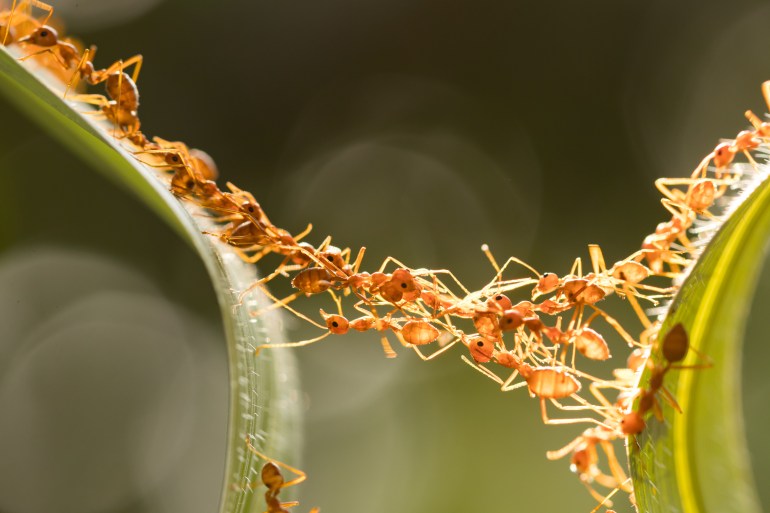Despite having about 250,000 neurons compared to the billions that we humans have, the ant kingdom still sets the best examples of the feats its people can achieve by working together.
Ant kingdoms have shown in a previous study the ability to avoid crowding, and ants know very well when to back off in order to make room for their team to become more effective and efficient in performing its tasks.
Diverse skills
A research study published in the journal "Insect Science" and quoted in brief by "Science Alert" indicated that the red fire ant of the type "Solenopsis invicta" uses a special skill to pave its way and build bridges that enable it to Passing on sticky surfaces.
This type of ant is generally known for its ability to use the bodies of its members to build bridges and transform themselves into lifelines that protect them from floods.
They can achieve this by clinging to each other using feet, claws and mouths.
But what is the exact mechanism that enables them to actually succeed in this task?
Each individual ant makes 14 contacts with its neighboring ants (Shutterstock)
In fact, each individual ant makes 14 contacts with the ants next to it, creating bubbles around it with the help of its waterproof exoskeleton, which helps it float.
The ants also use a trick to transport supplies that are difficult for them to transport, such as liquids, as they leave their waste and some tree leaves in those liquids, and then transfer these materials moistened with those liquids to their nests.
And some scientists have argued that the ants do this - in addition to using their pipe straws - as a mechanism for suctioning water and thus reducing the risk of drowning.
In the previous study, South China Agricultural University researchers showed that ants use the surrounding crumbs (in this case soil particles) to create a bridge over a sticky paraffin surface. The range is 20 centimeters from its circumference.
Ants transport liquid-soaked material to their nests as a ploy to transport supplies (Shutterstock)
bridge construction
According to the report published by the "Science Alert" website on the study on April 16, the team explained that "the ants were able to transfer nutrients after forming these bridges over the sticky surfaces, but failed to transfer the nutrients directly on the sticky surfaces or on the sticky surfaces." which contained a few of the molecules that make up those bridges."
The team also observed that ants formed these bridges over sticky surfaces that did not contain food, indicating that bridge-building behavior depends primarily on the presence of sticky surfaces rather than food.
Hence, the scientists believe that the ants evolved this mechanism to cover inaccessible wet surfaces when foraging, "giving this type of ant a competitive advantage over other ant species," the team says.
Recycling the surrounding environment crumbs helps in the process of organic soil turbidity (pixels)
However, the most surprising thing is the ability of ants to build a bridge from the particles of this soil over the surface of a sticky substance that is considered a repellent and repelling for ants, and the ability of ants to recycle the crumbs around it helps in the process of organic turbidity (Bioturbation) in which animals or Plants mix and stir the sediment and the soil around it, in a way that increases water permeability and improves soil fertility.

